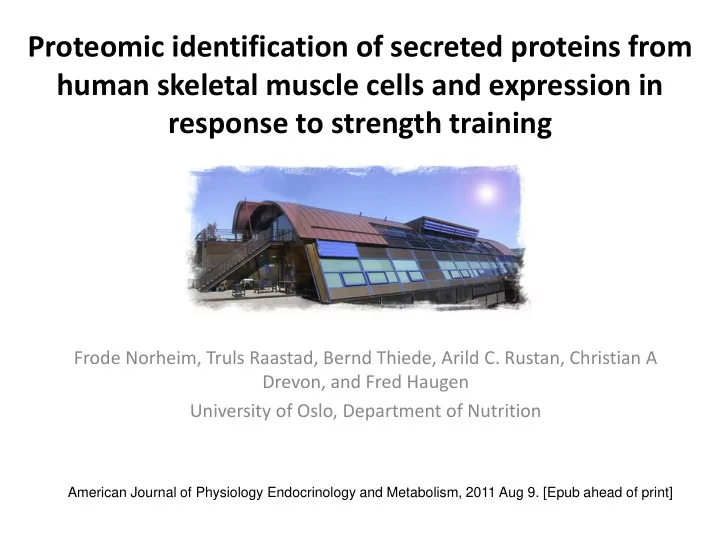

Proteomic identification of secreted proteins from human skeletal muscle cells and expression in response to strength training Frode Norheim, Truls Raastad, Bernd Thiede, Arild C. Rustan, Christian A Drevon, and Fred Haugen University of Oslo, Department of Nutrition American Journal of Physiology Endocrinology and Metabolism, 2011 Aug 9. [Epub ahead of print]
Physical activity & health Exercise offers protection against chronic disorders like: – CVD ; Thompson ATVB 2003, 23, 1319-1321 – Obesity ; Catenacci & Wyatt Nat. Clin. Pract. Endocrinol. Metab 2007, 3, 518-529 – T2D ; Knowler et al. NEJM 2002, 346, 393-403 – Osteoporosis; Gass & Dawson-Hughes Am J Med 2006, 119, S3-11 – Dementia ; Lautenschlager et al. JAMA 2003, 300, 1027-1037 – Depression ; Martinsen Acta Psychiatr Scand Suppl 1994, 377, 23-27 – Cancer ; WCRF report 2007
Proteins secreted from the muscle Aims: 1) Characterize proteins released from cultured human myotubes 2) Examine the effect of strength training on expression of secreted muscle proteins Nielsen R et al, Curr Opin Pharmacol, 2008
Differentiation of cultured human myotubes 7 days of differentiation Myoblasts Myotubes
Characterization of isolated human myoblasts Black: CD56 + Red: neg. Control
Proteome analysis of conditioned media • Three 175 cm 2 flasks confluent with myotubes • Collected media after 6 X 3 donors hours incubation • Concentrated media by spin colums • Analyzed by 1-D gel and Mass spectrometry
Identification of proteins secreted from cultured human skeletal muscle cells The classical secretory pathway 37
“Classically” secreted proteins identified – mRNA expression
mRNA expression of secreted proteins during myogenesis 7 days of differentiation Myoblasts Myotubes
Strength training • Strength training intervention lasting 11 weeks – Muscle biopsies from vastus lateralis (n = 10) and trapezius (n = 7): baseline and 11 weeks • RT-PCR • RPLP0 was used as endogenous control • We compared the relative gene expression after 11 weeks of strength training with the expression on baseline: Fold Change
Changes in skeletal muscle mRNA levels of secreted muscle proteins in strength training individuals
SPARC is a secreted muscle protein regulated by strength training
Conclusions • We have identified 17 muscle secretory proteins which is secreted from cultures of human muscle cells and expressed in human muscle biopsies ( m. vastus lateralis and m. trapezius ) • Compared to baseline, strength-training significantly increase expression of several different muscle secretory proteins • By defining the human skeletal muscle secretome in vitro , novel responses of skeletal muscle to strength training can be identified in vivo
Acknowledgement • Christian A. Drevon (UiO, Department of Nutrition) • Fred Haugen (UiO, Department of Physiology) • Truls Raastad (Norwegian School of Sport Sciences) • Arild C. Rustan (UiO, Department of Pharmaceutical Biosciences) • Bernd Thiede (UiO, The Biotechnology Centre of Oslo)
Recommend
More recommend